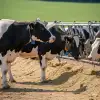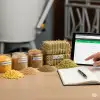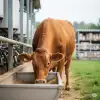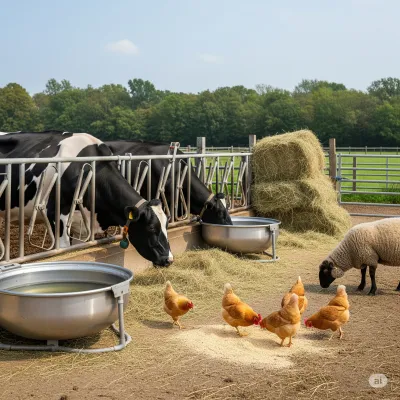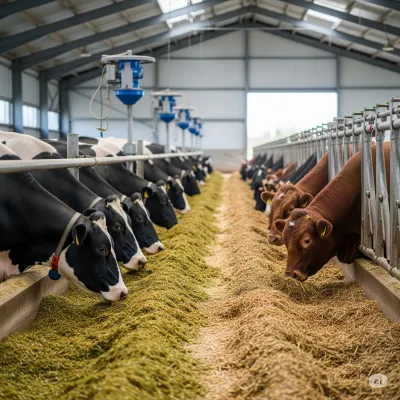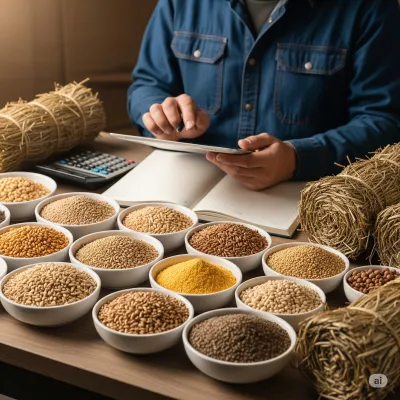How to Make Your Own Beef Feed: An Economical and Controlled Feeding Guide
Advantages of preparing your own beef feed, step-by-step formulation process, raw material selection, mixing, and application tips for economical and controlled beef feeding.

How to Make Your Own Beef Feed: An Economical and Controlled Feeding Guide
In beef cattle farming, feed costs are one of the biggest factors affecting profitability. While ready-made beef feeds are practical, formulating and preparing your own feed offers significant advantages in reducing costs, controlling raw materials, and feeding your animals according to their specific needs. So, what steps should you follow when creating your own beef feed? Here's a step-by-step guide.
Advantages of Making Your Own Beef Feed
- Cost Control: You can significantly reduce costs compared to ready-made feeds by sourcing affordable raw materials from the market.
- Quality Control: You can personally monitor the quality and freshness of every raw material you use.
- Flexibility: You can instantly adjust the ration according to your animals' age, breed, weight, and fattening period.
- Traceability: By knowing the exact content of the feed, you can more easily identify the cause of any nutrition-related problems that may arise in your animals.
Steps to Prepare Your Own Beef Feed
Creating your own beef feed is a process that requires knowledge, planning, and attention. Here are the basic steps you should follow:
1. Step: Determine the Needs of Your Beef Animals
The first and most critical step in preparing beef feed is to accurately understand the nutrient requirements of the animals you will be feeding. These needs vary depending on the animal's age, breed, initial and target weight, fattening period, and general health condition.
- Age and Weight: The protein and energy needs of young, growing calves differ from heavier calves nearing the end of the fattening period.
- Fattening Period: Animals' energy and protein needs change during the initial, middle, and final stages of fattening. Protein is more important at the beginning, while energy becomes more prominent in the final stages.
- Target Daily Live Weight Gain: You need to adjust the energy and protein density in your ration according to how much weight gain you target daily.
At this stage, seeking support from a **veterinarian or animal nutrition specialist** will help you determine the most appropriate nutrient levels (dry matter, crude protein, metabolizable energy, fiber, vitamins, and minerals) for your animals' needs.
2. Step: Select the Feed Raw Materials to Use
You must carefully select the raw materials you will use when creating your beef feed. When making your selection, consider the nutritional values, digestibility, palatability, availability, and cost of the raw materials.
- Energy Sources:
- Grains: Grains like corn, barley, and wheat are the primary energy sources in beef rations. They are high in starch and support rapid weight gain. Using them as **rolled barley** or cracked corn increases digestibility.
- Molasses: With its high energy content and palatability, it can increase feed intake.
- Protein Sources:
- Oilseed Meals: Products such as soybean meal, sunflower meal, and cottonseed meal are used to cover the protein deficit in the ration. Soybean meal is one of the most preferred due to its high protein quality.
- Forages:
- Silages: Silages like corn silage and alfalfa silage provide high digestible energy and fiber.
- Hay and Straw: Used to meet the fiber requirement of the ration, maintain rumen health, and encourage rumination. Although straw generally has low nutritional value, it is important as a rumen filler and fiber source.
- Mineral and Vitamin Sources:
- Macro (calcium, phosphorus, sodium, etc.) and micro (zinc, selenium, copper, etc.) minerals and vitamins (A, D, E) essential for healthy animal development and high productivity should be added to the ration as premixes. These premixes are formulated specifically for the animal's age and fattening period.
- Additives (Optional):
- Additives such as yeast, probiotics, and toxin binders can be used to support digestion, increase feed utilization, and prevent health problems.
3. Step: Formulate the Ration
This is the process of combining different feed raw materials in determined proportions to create a mixture that fully meets the animals' nutrient needs.
- Feed Analysis: Determining the nutritional values of each raw material you use (especially forages and grains) through laboratory analyses is crucial for accurate formulation.
- Calculation Methods: Ration formulation is usually done using simple mathematical methods like the "Pearson square method" or by using **computer programs** (e.g., feed formulation software) that provide more complex and precise results.
- Expert Support: Especially if you are preparing your own feed for the first time, getting professional support from an agricultural engineer (animal scientist) or animal nutrition specialist minimizes errors and helps you achieve optimal results. Experts can help you create the most suitable and cost-effective ration by considering your local resources and your animals' condition.
4. Step: Prepare and Mix the Feeds
To implement the ration you have formulated on the farm, it is important to use the correct equipment and methods.
- Crushing/Grinding: Grains (barley, corn, etc.) you will use should be crushed or ground to increase feed utilization.
- Weighing: Ensure that each raw material is **precisely weighed** according to its quantity in the ration. Electronic scales on feed mixers facilitate this task.
- Mixing: Homogeneously mixing all prepared feed raw materials is critical for the effectiveness of the ration.
- Feed Mixer: For large and medium-sized operations, a **feed mixer** is indispensable. These machines mix feeds completely and evenly, preventing selective eating by animals and ensuring they receive the same nutritional value with every bite.
- Loading Order: Generally, forages (hay, straw) are added first, then silage (corn silage), followed by concentrates (rolled barley, soybean meal), and finally mineral/vitamin premixes. This order ensures the best mixing quality.
- Mixing Time: Mixing should be done for a sufficient period (usually 5-15 minutes) depending on the machine model and ration content.
- Water Supply: Always ensuring free access to clean and fresh water near the feeders is vital for digestion and feed utilization.
5. Step: Apply Feeding and Observe Continuously
Your work doesn't end after preparing the ration and presenting it to the animals. Continuous observation and adjustments when necessary are essential for a successful fattening process.
- Feed Consumption: Check how eagerly the animals eat the feed and if there are any residues left in the feeders. If there are feed residues, review the quantity.
- Body Condition: Regularly monitor the live weights and body condition scores of your animals. Are they achieving the targeted weight gain?
- Manure Check: The consistency and appearance of manure provide important clues about digestive health. Digestive disorders (diarrhea, constipation) or issues like ruminal acidosis may indicate that the ration needs adjustment.
- General Health Status: Observe the animals' general vitality, appetite, and whether there are any signs of illness.
- Record Keeping: Regularly recording when you applied which ration, the animals' responses, live weight gains, and feed costs provides valuable data for your future feeding strategies.
Challenges and Solutions When Making Your Own Feed
- Procurement and Storage of Raw Materials: Finding quality raw materials at a reasonable price and storing them under proper conditions (free from mold, pests) is important.
- Precise Weighing: It can be challenging to precisely weigh small amounts of minerals and vitamins. Therefore, using premixes is more practical and safer.
- Time and Labor: Preparing your own feed may require more time and labor compared to using ready-made feeds. This should be considered, especially in large operations.
- Lack of Knowledge: There may be a lack of knowledge regarding ration formulation, nutrient requirements, and feed quality. In this case, seeking expert support is the best approach.
While making your own beef feed may require some effort initially, in the long run, it will provide you with significant cost advantages and more control over your animals, directly contributing to the success of your fattening operation.


